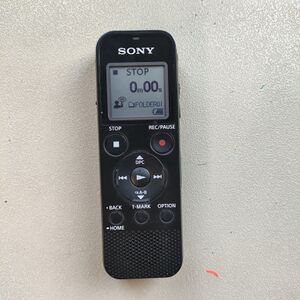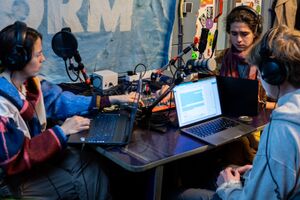User:Riviera/Broadcast seven
On the morning of Halloween 2023, me, Senka and Victor met at Worm to broadcast a radio show. The title of the broadcast was 'Personal Accounts of Irreplaceable Lace: A 200 year long history of lost and found'. This wiki post discusses that broadcast. I focus on the discussions which were had in the run up to the show, the broadcast itself and the feedback which was given in the Aquarium during the afternoon.
Making the broadcast
In preparation for the broadcast I recorded a 45 minute long 1/4" tape. That process is discussed here. Initially, there was a plan to transport the tape machine to the Radio Booth at Worm. In the end, I decided against this idea as the machine belonged to one of Joseph's friends and the bag for transporting the equipment did not seem very sturdy. It would have been necessary to carry the machine to Worm (it's heavy) and bring it back again. To reduce the chances of potentially damaging the machine, I instead plugged the Akai GX-4400D into a Sony IC Recorder ICD-PX470. Conveniently, the handheld recorder has a line input which made making a digital copy quite simple. The digital file was then broadcast on Tuesday.
Me, Senka and Victor had three meetings in advance of the broadcast. During these meetings we shared ideas, produced material and rehearsed what we would perform. Our first meeting was mostly conversational and sought to demarcate the direction in which we would take the broadcast. There was discussion of aliens and zombies, resources were shared and the decision was made to craft a narrative. Our next meeting was both longer and more productive. We figured out that the narrative would be split into three sections: past, present and future. The narrative would span 200 years from 1928 to 2128. We came up with names for the archivists who would be the protagonists of the narrative: Erhka and Akhre. These names are anagrams of Arkhe, the Greek word from which the English term "archive" is derived. Erhka, it was decided, would be an archivist from the past whilst Akhre would be the archivist from the future. Victor took the future, Senka took the past and that left me with the present. The middle section of the broadcast was structured a bit differently to the opening and closing sections. Rather than writing character-driven, fictional voice memos, I spoke as a narrator and discussed the 'history' of the archive between 1998 and 2057. This was with the agreement of Senka and Victor.
During our second meeting, we worked with three pieces of paper, one for each time period. We decided an 'exquisite corpse' would be an effective way to generate material, and introduce a diversity of ideas into the narrative. Each of us had a say in each section of the storyline, providing ideas, keywords and possible plot points. We then transcribed the paper based notes onto an Etherpad so that each of us could be reminded of the content of the discussion and what had been written down. Because it was Halloween we were interested to make a story with elements of Gothic horror, but also speculative fiction. We explored dichotomies and themes which would characterise each time period. The following table illustrates these themes.
| Past | Present | Future |
|---|---|---|
| Birth of Modernism | Liminal | Solar Punk |
| Industrial Revolution | Translation | Alive (Undead) |
| Consumer Society | Passion (Passive + Active) | Hopeful |
| European politics | Change (Climate (/) Politics) | Repurposed |
| disposable things |
To forge a coherent narrative, I built on what had been discussed in our meetings and copy which had been written in the Etherpad. For example, Senka wrote about the quality of the material of Lace — a fictional audio recording material which we invented and around which the narrative unfolded. There was a practical reason for inventing the material; at first we thought simply to go with tape. However, Senka, whilst researching the historical context of the history of tape discovered something surprising. Tape was invented in Germany in the 1920s, however it was kept a secret and was not widely used until the end of WWII. After finding this out Senka wrote about it in the Etherpad. They made a few suggestions about how we might proceed:
- Adjust the dates of the fictional narrative to fit with the history of tape
- Write an alternative history in which WWII never happened
We agreed that the first option was inconvenient; beginning in the 1950s would have been disruptive to what Victor and I had written. The second option was inspired by a podcast Senka had heard of called 'Within the wires'. This podcast was a fictional narrative which imagined a 20th Century without the concept of a nuclear family. The podcast, to paraphrase Senka, elaborated on an alternative history in which WWII never happened. This was partly because nation states looked very different because nuclear families were considered barbaric. I suggested that whilst that might work in that podcast, it might not work in our broadcast. An alternative, I suggested, was to imagine a fictional audio recording medium. Doing so would allow us to keep the dates the same without ending in the murkiest territories of alternative histories about WWII. Senka responded with an enthusiastic 'YES' in the Etherpad and so we went ahead with the history of lace. I decided to call the material lace because I thought that flat shoelaces looked a bit like magnetic tape, but were sufficiently different.
Senka went on to describe the qualities of this fictional material. I expanded on Senka's discussions of the medium, referring to it's 'gummy' quality and the optimal temperature at which it should be stored. This provided consistency in the narrative. As the author of most of the material in the present moment, I also endeavoured to leave the plot open such that Victor could pickup on narrative strands in the future. Likewise I was inspired by what he had written and sought to write copy which would bridge the lives of Erhka and Akhre.
At our third meeting, I played Victor and Senka the tape I had made. Whilst doing so, we read through the material we had produced to check how much time it would take to read aloud. Following the read-through, we fed back to each other, highlighting plot-points and discussing opportunities to make the broadcast more coherent. We next collaborated on developing the written material through another exquisite corpse exercise. With regard to the structure of the broadcast, we decided to intersperse the sounds of the tape and the spoken narrative elements. This was both a practical — it was difficult to speak over the noisy sounds — and aesthetic — to suggest the passing of time — decision. At this meeting, I also recorded the sound of the tape being rewound from the end to the beginning. Vice versa, I recorded the tape being played on fast forward from the start to the end. This gave us an additional ten minutes of audio material.
Broadcasting on Tuesday
We met around 9:45 at Worm to set up for the broadcast. I had borrowed a mini-jack to phono cable and two phono to jack adaptors from the XML lab to connect my laptop to the mixing desk. Generating pre-recorded material and playing this on air was pragmatic for several reasons. Firstly, we knew how much material we would have. Secondly, and more importantly, it allowed us to mute the microphones in the radio booth and confer with each other about our next steps during the broadcast. This was in contrast to the first broadcast I made with Lorenzo and Senka in week three. Then, the mics were live for much of the broadcast which gave us little opportunity to discuss with each other and cue various moments.
Unbeknown to we caretakers, the streaming software which normally runs in the background on the computer in the radio booth was not running. As such, it only transpired that we were not broadcasting what we were performing after forty minutes. Senka's partner messaged Senka and asked when we were going to start speaking. It turned out that ska music and string instruments were being broadcast for a third of the time that we were supposed to be on air. Fortunately, we were recording everything and there was an opportunity to replay the 'lost' audio to the group on Tuesday afternoon. Doing so, the group agreed, made the narrative make more sense.
We encountered a second technical hitch during the broadcast. Fortunately, this arose just after we fixed the streaming issue so we were not confronted with two issues simultaneously. In short, Audacity stopped working. Why? Because the file had not been saved to the correct location and the computer hard drive rapidly became full. Thankfully Florian was there and he helped us fix both issues as they arose. We lost a couple of minutes of the tape recording being broadcast in the recording, but this was a relatively inconspicuous error. It was a good stroke of luck that the recording did not stop whilst we were talking / telling the narrative.


